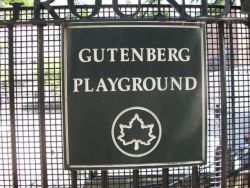Gutenberg Playground
Gutenberg Playground
This playground is named in honor of Johann Gutenberg (c. 1397Α1468), the German pioneer in the field of printing who is widely regarded as the European inventor of movable type. The Chinese are credited with the invention of printing type—a block of wood, metal, or other material bearing a raised letter or character on one end, that, when inked and pressed upon paper, leaves a printed impression. Movable metal type was used in Korea as early as 1403; however, it was Gutenberg who developed this technology in Europe.
Details about Gutenberg’s life are few. He probably trained as a goldsmith or a gem cutter and polisher. While Gutenberg may have invented movable type in Strasbourg in 1436 or 1437, the work attributed to him was done in Mainz, including the famous Mazarin Bible, popularly known as the Gutenberg Bible. Completed by 1455, it was the first European book to be printed from movable type. The text was in Latin, composed in a Gothic type, illuminated by hand, on vellum and paper. Gutenberg's landmark contribution to the printing trades has endured to the present day. Most printers used a form of Gutenberg's hand press until the 19th century, and generations of printing students and artists continue to learn and experiment with the technology he invented.
Gutenberg Playground is located adjacent to the High School for Graphic Communication Arts, formerly known as the New York School of Printing. This vocational institution was founded in 1925 to prepare students for careers in the printing trades. When the school outgrew its quarters, plans were made to relocate to a dedicated facility near the heart of the printing industry in midtown Manhattan. Designed by the architectural firm of Kelly and Gruzen, the new sevenΑstory building was the largest printing school in the United States when it opened in 1958. It showcases several significant works of art, including Hans Hofmann's Abstraction mosaic (1957) on the auditorium's south facade and Ernst Plassmann's bronze sculptures of celebrated printers Benjamin Franklin and Johann Gutenberg (both c. 1872), located in the lobby.The schoolyard was built by the Board of Education, and it opened with the school in 1958. Since 1959 the playground has been jointly operated by Parks and the Department of Education. The smooth paved surface provided a favorite roller hockey spot for National Hockey League allΑstars Brian and Joey Mullen, whose childhood home was across the street from the playground.A renovation of the playground in 2001 added a new handball court, benches, pavement, fencing, and plantings. The project’s completion was celebrated on the same day as the 75th anniversary of the opening of the High School of Graphic Communication Arts.
Check out your park's Vital Signs
Clean & Safe
Green & Resilient
Empowered & Engaged Users
Share your feedback or learn more about how this park is part of a
Vital Park System


